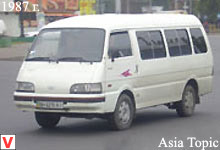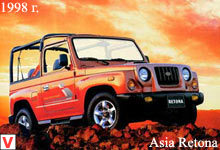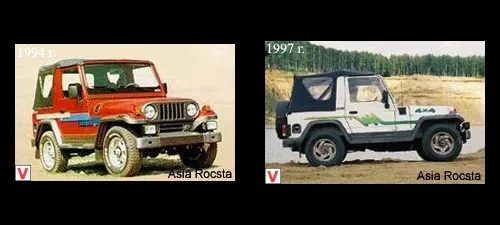
The Asia Rocsta debut took place in 1989. The model was equipped with a five-speed manual gearbox and one of two engines - petrol (1.8 l, 86 hp) and atmospheric diesel (2.2 l, 72 hp). The mechanical part of this SUV is copied from the legendary Willis, the very one that, according to the land-lease, was delivered to our country by the allies during the Second World War. In 1994, a modernization was carried out, referring to the exterior and interior, as a result of which the front part of the car began to resemble the first-generation Mitsubishi Pajero. At the same time, sales of cars with a body extended by 45 cm began.
In parallel with the “new” Rocsta, previous modifications were also made. In 1996, more than a hundred cars were assembled from vehicle sets at the Avtotor plant in Kaliningrad. All of them were diesel and, depending on the configuration, they could have air conditioning and power steering.
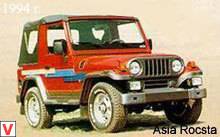
In 1998, Rocsta was discontinued, giving way to the new Retona conveyor. During the ten years that Rocsta has stood on the conveyor, several modifications of it were produced, differing mainly in the type of top and body length. As for the roof, it could have been tarpaulin, removable plastic and all-metal, and there were two body options: the short one was 3.7 m long and the longest one was 450 mm longer. On the basis of the latter, a double pickup truck was produced, but it was not exported and was sold only on the domestic market of Korea.
In addition to the body, modifications differ in design of the front. The corrosion resistance of the body can be described as mediocre, first and foremost, rust appears under decorative plastic lining. But the transformation of local rust through corrosion occurs slowly. For Rocsta, two engines were offered: a 1.8-liter, 86-horsepower gasoline and a 2.2-liter diesel engine, developing 72 hp. Machines equipped with a gasoline engine were not in particular demand in Europe and were supplied mainly to the domestic market, diesel is of the greatest interest. This four-cylinder swirl chamber with overhead camshaft is not a Korean development. It was released under a license agreement.
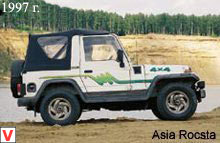
This engine was equipped with some of its models by the Japanese company Mazda. As befits a diesel engine, the engine has a moderate appetite and does not consume more than 10-12 liters of diesel fuel, even in heavy off-road conditions. On average, the fuel consumption in the city-highway mode is about 8 l / 100 km. Rocsta is a full-fledged off-road vehicle equipped with an appropriate transmission in which the rear axle is the main one, and the front one is connected manually and is rigidly connected with it (there is no center differential in the transfer case).
Front hubs are equipped with freewheel clutches, which, when driving with rear wheel drive, do not spin around the entire front axle mechanism, idling, which has a beneficial effect on the life of all its elements and also reduces fuel consumption. The clutches are activated manually, and in order to be able to use all-wheel drive, you must first get out of the car and turn the switch on the hub from position 2 to position 4, and then from the salon connect the front axle with a lever. The gearbox was installed only a five-speed manual, and the transfer case - a two-speed. The role of the guides and at the same time elastic elements is played by archaic springs.
For damping applied oil dampers, which go very long. The term of their service does not exceed 30-40 thousand km. Probably, this is because this short-base car is characterized by increased “trembling” and “jumping ability”.
Due to the low weight, its successful distribution along the axes and the high-torque Rocsta diesel, almost no competitors are in terms of terrain. It is worth mentioning that the vast majority of cars do not have any modern elements of comfort, and in the steering can easily be absent power steering. However, occasionally there are instances with air conditioning and electric windows. The cabin is tiny in size, and only a large travel bag fits in the trunk. With the placement of the same driving problems and there is a rather large drivers, which is achieved due to the large range of adjustments of the seat and the angle of the steering column.
With all its primitiveness, the model was quite successful (given the small volume of production) sold in Europe.
